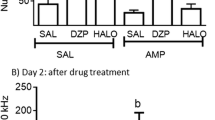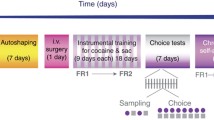Abstract
To investigate the hypothesis that sulpiride potentiates stereotyped locomotion at an intermediate dose of amphetamine, rats were assigned to one of four treatment groups (n=7 per group): vehicle + saline; 20 mg/kg sulpiride + saline; vehicle + 3.5mg/kg amphetamine; 20 mg/kg sulpiride + 3.5 mg/kg amphetamine. An automated tracking system was used to record distance moved and sequences of movements between quadrants in a circular open-field. The results showed that amphetamine increased horizontal distance moved, and increased the number and proportion of thigmotaxic trips around the perimeter of the apparatus. Sulpiride reduced amphetamine-induced hyperactivity and the number of perimeter trips, but had no effect on the proportion and maximum run length of perimeter trips. Thus sulpiride reduces the hyperactivity produced by an intermediate dose of amphetamine, but does not appear to affect the stereotyped nature of locomotion under the drug.
Similar content being viewed by others
References
Fishman, H.B.R., Feigenbaum, J.J., Yanai, J., & Klawans, H.L. (1983). The relative importance of dopamine and norepinephrine in mediating locomotor activity.Progress in Neurobiology, 20, 55–88.
Geyer, M.A., Masten, V.L., & Segal, D.S. (1986). Behavioral effects of xylamine-induced depletion of brain norepinephrine: Interaction with amphetamine.Behavioral Brain Research.21, 55–64.
Geyer, M.A., Russo, P.V., & Masten, V.L. (1986). Multivariate assessment of locomotor behavior: Pharmacological and behavioral analyses.Pharmacology, Biochemistry & Behavior, 25, 277–288.
Kenyon, P. (1990a). TRACKER: Computer-assisted analysis of animal motor activity.Laboratory Microcomputer, 9, 50–59.
Kenyon, P. (1990b). STEREO: A program to analyse stereotyped open field locomotion.Current Psychology: Research and Review, 9, (4), 333–335.
Ljungberg, T., & Ungerstedt, U. (1985). A rapid and simple behavioral screening method for simultaneous assessment of limbic and striatal blocking effects of neuroleptic drugs.Pharmacology Biochemistry & Behavior, 23, 479–485.
Mueller, K., Hollingsworth, E.M., & Cross, D.R. (1989a). Another look at d-amphetamine-induced stereotyped locomotor activity in rats using a new statistic to measure locomotor stereotypy.Psychopharmacology, 97, 74–79.
Mueller, K., Kunko, P.M., Whiteside, D., & Haskett, C. (1989b). Time course of amphetamine-induced locomotor stereotypy in an open field.Psychopharmacology, 99, 501–507.
Rebec, G.V., & Bashore, T. (1984). Critical issues in assessing the behavioral effects of amphetamine.Neuroscience & Biobehavioral Reviews, 8, 153–159.
Renner, M.J., Pierre, P.J., & Schilcher, P.J. (1990). Contrast-based digital tracking versus human observers in studies of animal locomotion.Bulletin of the Psychonomic Society, 28, 77–79.
Robertson, A. & MacDonald, C. (1985). Opposite effects of sulpiride and metoclorpramide on amphetamine-induced stereotypy.European Journal of Pharmacology, 109, 81–89.
Schiorring, E. (1979). Study of the stereotyped locomotor activity in amphetamine treated rats.Psychopharmacology, 66, 281–287.
Sharp, T., Zetterstrom, T., Ljungberg, T., & Ungerstedt, U. (1986). Effect of sulpiride on amphetamine-induced behavior in relation to changes in striatal dopamine release in vivo.European Journal of Pharmacology, 129, 411–415.
Szechtman, H., Eilam, D., Teitelbaum, P., & Golani, I. (1988). A different look at measurement and interpretation of drug-induced stereotyped behavior.Psychobiology, 16, 164–173.
Tamminga, C.A., & Gerlach, J. (1987). New neuroleptics and experimental antipsychotics in schizophrenia. In H. Y. Meltzer (Ed.),Psychopharmacology: The third generation of progress (pp. 1129–1139). New York: Raven Press.
Teitelbaum, P., Pellis, S.M., & DeVietti. (1990). Disintegration into stereotypy induced by drugs or brain damage: A microdescriptive behavioral analysis. In S.J. Cooper & C.T. Dourish (Eds.),Neurobiology of stereotyped behaviour (pp. 169–199). Oxford: Clarendon Press.
Tschanz, J.T., Rebec, G.V. (1989). Atypical antipsychotic drugs block selective components of amphetamine-induced stereotypy.Pharmacology Biochemistry & Behavior, 31, 519–522.
Winer, B.J. (1971).Statistical principles in experimental design. New York: McGraw-Hill.
Worms, P. & Lloyd, K.G. (1979). Predictability and specificity of behavioral screening tests for neuroleptics.Pharmac. Ther., 5, 445–450.
Author information
Authors and Affiliations
Rights and permissions
About this article
Cite this article
Kenyon, P., Moore, S. & Hampson, J. Effect of sulpiride on amphetamine-induced activity and stereotyped locomotion. Current Psychology 11, 241–253 (1992). https://doi.org/10.1007/BF02686844
Accepted:
Issue Date:
DOI: https://doi.org/10.1007/BF02686844




